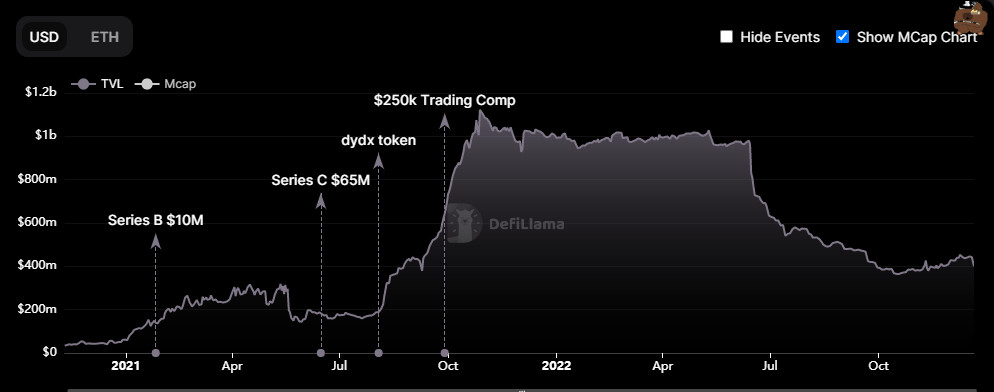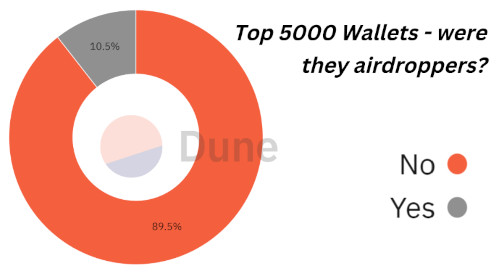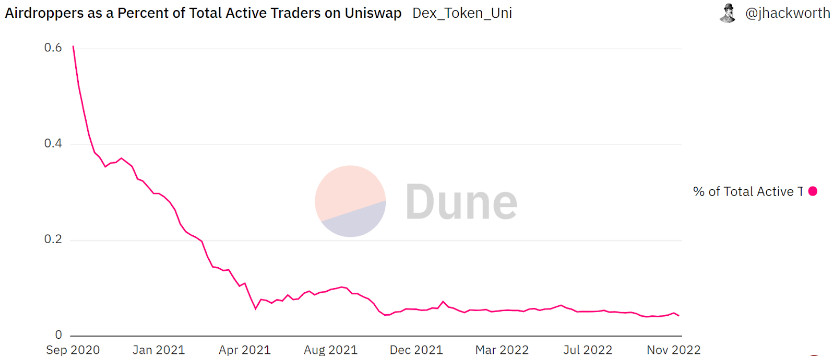How to make an airdrop to reward your crypto community
As the inner workings of the crypto market are mainly about financial incentives, an airdrop is a great tool to grab the market’s attention and build an audience. Airdrops have recently become one of the most popular marketing tools in crypto. They were always popular, but in the center of a bear market, when most investors are rekt, the airdrops are even more welcomed. However, several elements make up a good airdrop. Unfortunately, most projects do not conduct airdrops properly.
Today, we will show you the mystery behind creating an effective airdrop campaign. After reading this article, you will know which protocols can do airdrops, what are the best airdrop case studies, and how to prevent Sybil attacks.
Let’s dive into the rabbit hole.
Uncover the Crypto Airdrops
But before we start: what does a lousy airdrop look like?
First: it’s not measured by the number of participants (unfortunately, most projects think it is).
How is that possible?
Crypto airdrops are not about the CONSCIOUS participation.
It’s not about signing up or logging in to receive free money.
The best airdrops are the airdrops without the released information of doing it.
A Gleam.io-based airdrop where people have to sign up and complete social media tasks (i.e., RT tweet and follow account) is not an effective marketing tool.
Why? Such activity is only a single interaction from the user: your profile gets thousands of likes and retweets of the tweet, but it’s not done by the users that will stay with you. They came only for money.
They are not even users of your app, so why reward them?
Most airdrops are artificial
The main takeaway is that the spike in engagement and social media reach is very artificial, and you won’t be able to maintain it in the long term. When the airdrop is completed, the users will be gone. It’s not how you want to grow your social media account, reach, or the project itself.
Remember: all the giveaways you see on Twitter are not worth the spent budget. Because it’s about the short-term “gratification” for the project in the form of likes and comments, but in the long-term, you end up with a “dead” social media account where your engagement (built artificially) drops to 0.
But airdrops do not have to be done like that. There are many more ways to engage your users, make an airdrop, and create a win-win-win situation.
What’s the point of the airdrops?
Let’s start with the concept behind all airdrops:
What’s the point? Making an airdrop is mainly about rewarding early users, gamification, broadening social media outreach, growth hacking, and making your DApp as popular as possible.
However, the main pain point of all startups is how to make users stay with your project. The answer is airdrop + gamification, meaning the airdrop does not have to be easy to discover.
You need to put some tips on your Discord, your website, or inside the whitepaper and say nothing more.
Then, as time flows and you grow organically, smart crypto adepts will start seeing potential in your project and hunting for an airdrop.
One thing before we move forward
The important thing is: not every project can conduct the airdrop. It works best for projects that are DApps, financial products, staking & farming protocols, lending & borrowing, etc.
Why is that?
Because such protocols have a product that can be released as a testable beta.
If your product is focused on serving the users (i.e., leverage trading or vault options), you can gather some early users and reward their contribution.
If the company focuses on building the wallet SDK, infrastructure, or delivering consulting services, conducting an airdrop does not make sense.
What does the proper airdrop process look like?
Now, the meat. Here’s what we truly recommend when conducting an airdrop:
(note that the successful airdrop contains building the product – dropping money out from nowhere is not a successful strategy)
- Start building a product.
- Simultaneously, start to push the narration organically on Twitter and build the product in public.
- Then, release the open beta of your DApp without announcing the official launch.
- Treat the open beta as the chance to improve your product before the launch.
- That’s why you need the form on the open-beta page where the users can provide feedback. They can also do it via Twitter or Discord.
- In the form, you can gather the user’s information like name, email, ERC-20 wallet address, plus Twitter & Discord handles.
- Then, implement the changes to protocol
- Make an airdrop
Now, you can kill a couple of birds with one stone:
- Conduct the airdrop for early users that used your protocol. If you launched a DEX, you could set the airdrop-receiving criteria for the DEX swaps, liquidity-providing, and Discord / social media activity. All the users that meet those conditions get a small % of the total supply in the form of the airdrop. Tip: you can also set some multipliers: i.e., the bigger the trading volume, the bigger the number of tokens that will be airdropped.
- Moreover, by conducting an airdrop, you can make liquidity for VC investors. How? VCs often invest in the company by buying shares exchangeable for the tokens. Some of the tokens can be unlocked at the exact moment early users will get their token rewards. Add the pre-sale for the community, and list the tokens meeting the needs of these groups at once.
- If the airdrop is significant (and people get a lot of money), the buzz marketing will continue to grow. How so? Instantly, all the airdrop hunters will start posting on Twitter they got an airdrop from protocol X, and you will get attention from the market. Check what happened with the $APT token mentioned at the beginning. Their ecosystem skyrocketed, and instantly the crypto Twitter knew about it.
An airdrop, in a nutshell,
Reward the early users, enable investors to exit with a profit, and use growth hacking strategies to grab the market’s attention.
How do you make hints for an airdrop to ensure the users will engage?
We will share some tricks:
- Put the investors’ logos on the website. How is it a hint? VCs need to cash out, and most often, they buy the shares in the company that is exchangeable for the token. For intelligent users, it’s a clear suggestion that the token may appear one day (and they will start using your DApp).
- Put the leak in the Whitepaper or Litepaper: for example, you can write that you plan to launch a DAO one day. DAO requires governance tokens. It can be another hint that the token will appear (and the airdrop will be conducted).
- Refuse to conduct the airdrop: it’s a “poker move”, but experienced investors will know the drill. They are aware of the fact many projects refuse to launch the token, but they have an intention to eventually do it (and conduct an airdrop) one day.
Examples: Arbitrum and LayerZero. They left the code snippets with the token leak, but when officially asked about the token, they denied they were working on it. That said, they make the inexperienced airdrop hunters stay away from their project, but the experienced people know what’s going on.
Key takeaway:
Turn the process of hunting the airdrop into the game. Make people engage. Don’t set the entry-level easy, like the projects doing simple, gleam giveaways where you just need to click to get money.
Instead, reward the actual users of your DApp.
How to approach airdrops in tokenomics?
Before diving into the dark side of airdrops, we need to address the organization of airdrops in terms of token metrics.
Note that the airdrop tokens should be a small part of the token allocation chart.
Let’s be honest: airdrop is a genius financial incentive and a great marketing growth hack, but it generates selling pressure.
If the airdrop’s part of the total supply is too big, the selling pressure would be too high, which may cause the price to dump, which you probably don’t want to see.
The safe approach is to allocate 1%-3% of the total supply to reward the early users.
Sybil addresses and the airdrop organization
However, there is also the dark side of launching airdrops: the Sybil attacks.
Let us explain: some people hunt airdrops for a living. So they set up multiple wallets and social media accounts and seek airdrops on a bigger scale.
They make big money when they find an airdrop that pays $20k / wallet (with activities on 5-10-15 wallets).
Key point: they will dump received tokens
Your interest is to avoid token dumpers and those here only to earn on your airdrop.
That’s where the Sybil addresses enter the chat: it often happens that one investor uses dozens of wallets.
Your role as a project is to identify and prevent the participation of people who try to circumvent the game’s rules.
Let us show an example:
Optimism as the case study of excluding Sybil attackers
As you probably know, Optimism is one of the biggest Ethereum L2s. They have over $1.6B in TVL and are backed by the biggest crypto VCs. Recently they launched an $OP token airdrop, but the process wasn’t as typical as in other projects.
Firstly, they allowed people to check how many tokens they were eligible for (just check, without the possibility of claiming).
While waiting for better market conditions to launch the airdrop, they identified Sybil wallets.
Official announcement:
“Optimism is for the people, not the sybils. We’ve been carefully analyzing OP Airdrop #1 for Sybil attackers that slipped through the cracks. We’re happy to announce that we’ve removed an additional 17k Sybil addresses and recovered over 14 million OP. Bye bye, sybils!”
Those 14M $OP has been given to the honest users, which means they got even more tokens (and the market valued such an approach even more).
With that move, Optimism has shown they value fair conditions and stand for honesty, which leveraged its social media engagement.
As a result, their TVL has grown from $300M to $1.6B now (in less than six months).
Three Well-known Airdrops in The Web3 History (And How They Rolled Out)
Uniswap $UNI Airdrop
Uniswap is the king DApp of all crypto apps. They created the definition of DeFi and built the well-known decentralized exchange for the whole web3 space, serving all the EVM-based blockchains.
Currently, they are generating around $1.5M in fees PER DAY!
But it’s not the most exciting thing here. Not everyone knows that at the time, they conducted the airdrop for early users that made the swaps on Uniswap when it was in BETA.
As a reward, each active user got 400 UNI tokens worth $18k at an all-time high.
After such an event, Uniswap became the largest DEX in the crypto space. The airdrop definitely helped them to reach the highest trading volume among all the protocols and get to over $2.5B in TVL.
dYdX $DYDX Airdrop
dYdX is the permissionless DeFi trading protocol. Think about it like about decentralized futures protocol. On Binance, you can do the same thing, but all the operations are regulated via KYC, and you need to trust a third party.
dYdX shifts the approach: instead of depositing the money, you store the funds in your non-custodial wallet (not on the exchange), and interact with their interface.
dYdX enables trading with max. 20 leverage.
And… They also conducted an airdrop back in 2021.

source: defillama.com
It was one of the most profitable airdrops in web3 history.
For a $100 swap, you could get an airdrop worth $50k or more.
Did an airdrop make an impact on the protocol itself?
Of course. dYdX has quickly become the alternative to Binance or ByBit trading platforms.
After their token launch (and series C), the TVL has skyrocketed from $187M to nearly $1.1B and is now at $403M.
Ethereum Name Service $ENS Airdrop
Now, the ENS: Ethereum Name Service protocol allowing to buy your own domains in web3 (domains end with .eth).
It works in such a way: you type in the domain and check if it’s free or taken, and if it’s free, you can choose a timeframe for which you want to buy it. Then, pay in eth, and you receive an NFT representing your wallet address.
Usage of ENS
Whenever your friend sends you the funds, instead of sending him (or her) your address, say, “send it to eric.eth”. After typing it, your address pops up.
Back to the ENS: all the funds generated from the name sale go to DAO, making it one of the most profitable DAOs in the space, with $2-$5M in monthly revenue.
Moreover, they conducted an airdrop for early domain holders. The conditions: the more domains you held, the more ENS tokens you could get.
The airdrop from Ethereum Name Service was worth around $20k.
How did it impact the company itself?
Month by month, ENS is beating its records regarding the number of registered domains.
Look at the stats from October:
- 174k new .eth registrations (total 2.75m names)
– 25k new eth accounts w/ at least 1 ENS name (total 594k)
– 8,173 avatar records set (total 58k)
– 1,851 DWeb content records set (total 15,685)
The $ENS airdrop was a massive growth hack regarding attracting users with the protocol.
How does making airdrops affect the token price in the long term?
All of the stuff above sounds great. People making $50k in airdrop seem like a massive success.
However, we must analyze the benefits of airdrops for the projects themselves. At the end of the day, an airdrop is just another marketing tool from many accessible.
So, how did tokens that had been airdropped perform after the token launch?
Let’s go back to Uniswap $UNI for a moment.
$UNI is the first airdrop in the history of crypto.
Detailed analysis of the outcome of the UNI airdrop concluded that… the airdrop results were missed.

source: dune.com
Check the numbers:
- Over 250k wallets that interacted with the protocol were eligible for the airdrop
- Each wallet got 400 UNI, worth $1200 at the time
- The market cap of $UNI increased to $5B, making $UNI an airdrop worth $18k (at the ATH)
- Interestingly, almost 93% of all wallets did not hold UNI today
- 99,4% of wallets DID NOT buy more UNI after the airdrop
- 93% of airdroppers have sold all their $UNI.
Is selling airdrops bad? Of course, not. That’s how incentive mechanisms among crypto communities work.
But you, as a web3 startup, should care about the number of users.
Rules 82: each airdrop’s “duty” is to increase the number of users
Unfortunately, it was not the case for $UNI.
People that got an airdrop sold $UNI, and most of them never used Uniaswap again!

source: dune.com
The curve has been significantly down in the last 2 years.
Does it mean they’ve failed?
We don’t think so. The $UNI team created the most bullet-proof business model among all the protocols that PRINTS money from fees.
Back on the airdrop track: Uniswap has millions of users now, but most early adopters are no longer users.
Does it mean that the airdrop model is fundamentally cracked?
Well, it all depends on the projects and performance.
You can’t predict how the airdrop will perform.
But the $UNI airdrop can show you something:
- Campaign Cost: $351M
- Trading Fees: $1,2B
- Trading Fees from Airdrop Users: $208M
- Sales Efficiency: 0.17
- Payback Period: over four years
If you treat airdrops as marketing tools that are one of many to use, your budget is narrowed, and you need an effective method to get users, airdrop may not be the one you should choose.
According to this article, airdrops are 4x-7x more expensive than traditional ways of sales, marketing, and getting users.
“So, no airdrops at all?”
Try to learn from the failed ones and invent a more efficient model.
Bottom Line
Thanks for your time! When conducting an airdrop, ensure you have a proper market maker to help you provide liquidity and extract the maximum value from the listing.
If you want to take care of your token listing from the financial side, contact Empirica, and we will help you.




